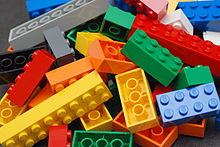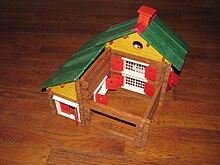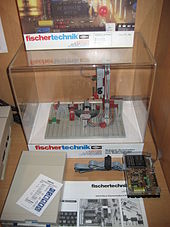Construction set
This article has multiple issues. Please help improve it or discuss these issues on the talk page. (Learn how and when to remove these template messages)
|


60 Fullerene.





A construction set is a set of standardized pieces that allow for the
Toys
Psychological benefits
Construction toy play is beneficial for building social skills and building trust in others because it acts as a collaborative task where individuals have to cooperate to finish the task – building an object out of Lego, for example. The effect was found in high school students.[1]
For children specifically, children who complete models using toy building blocks have much better spatial ability than children who do not complete such models. Spatial ability also predicts completion of models.[2]
Construction toy play is also beneficial for
Categories
Construction sets can be categorized according to their connection method and geometry:
- Struts of variable length that are connected to any point along another strut, and at nodes.
- Tesseract connection points are initially flexible but can be made rigid with the addition of clips.
- Struts of fixed but multiple lengths that are connected by nodes are good for building space frames, and often have components that allow full rotational freedom.
- Playskool Pipeworks, Cleversticksand interlocking disks in general.
- D6h nodes are used for interlocking disks.[4]
- Ih (*532) nodes are used for Zometool
- Panels of varying sizes and shapes
- Panels of varying sizes and shapes are connected by pins or screws perpendicular to the panels, which are good for building FAC-System, Constructo Straws, and Überstix
- Panels of varying sizes and shapes with flexible panels or hinges between panels such as Tog'l, Jovo Click 'N Construct, Polydron.
- Panels of varying sizes and shapes are connected by pins or screws perpendicular to the panels, which are good for building
- Struts and panels
- Girder and Panel building sets
- Synestructics (does not make pentagonal structures)
- Ramagon (some panels include studs for connecting with Lego clones)
- Geomag (components are magnetic)
- Bayko
- Building components with various methods of connection include:
- Spherical magnets
- Many marble run toys are construction sets.
Influence on architecture
Renowned architect Frank Lloyd Wright credited his childhood building blocks designed by Friedrich Fröbel as a major influence, and his son John Lloyd Wright invented the widely-known Lincoln Logs building set.[5] In addition to teaching architectural concepts such as modularity and load-bearing construction,[6] many architects credit construction set play as influencing their later design.[7][5][8]
See also
- Pontiki, construction toy for building models of unusual creatures
- Unit block
References
- .
- S2CID 22808504.
- S2CID 9889621.
- S2CID 208759028.
- ^ a b Heathcote, Edwin (9 August 2013). "Toytown and the city". Financial Times. The Financial Times Limited. Archived from the original on 15 August 2013. Retrieved 17 December 2013.
- ^ Stewart, Matt (12 June 2013). "Modern toys curb creativity – academics". Stuff.co.nz. Fairfax New Zealand Limited. Archived from the original on 19 December 2013. Retrieved 17 December 2013.
- ^ "Hurtownia zabawek w Wólce Kosowskiej". Retrieved 14 July 2023.
- ^ Anthony, Christopher. "Quelle Kindersuche". Children playground. Retrieved 15 March 2023.
